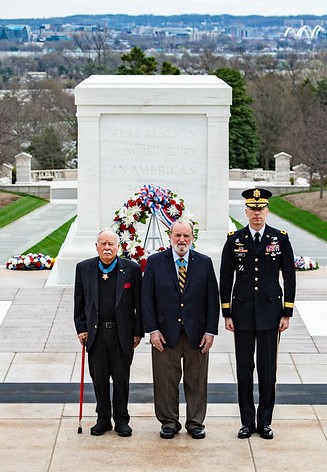
Medal of Honor recipients U.S. Marine Corps Col. (ret.) Barney Barnum (left) and U.S. Army 1st Lt. Brian Thacker (right) lay a wreath at the Tomb of the Unknown Soldier on Medal of Honor Day, March 25, 2022.
(U.S. Army photo by Elizabeth Fraser/Arlington National Cemetery)
On National Medal of Honor Day, March 25, 2022, two Vietnam veterans, with Medals of Honor draped around their necks, laid a wreath from the Congressional Medal of Honor Society at Arlington National Cemetery’s Tomb of the Unknown Soldier. The two men together symbolized the opening and closing of U.S. involvement in the Vietnam War. Barney Barnum, a retired colonel in the U.S. Marine Corps, earned his medal on December 18, 1965, as American grounds troops began arriving in South Vietnam. Brian Thacker, who served as a lieutenant in the U.S. Army, earned his on March 31, 1971, as U.S. troops gradually withdrew from the country.
Barnum earned his Medal of Honor outside the village of Ky Phu, in Quang Tin province, where he took over a company after its commander was mortally wounded. An artillery forward observer, Barnum aided the commander and then strapped a radio onto his own back, assumed command and rallied the men, despite heavy enemy fire. He reorganized the unit, replacing key personnel who had been wounded or killed, and led an attack on the entrenched enemy — constantly exposing himself to fire to point out targets. Once the company cleared the area, Barnum called in helicopters to evacuate the wounded and dead. He then assisted in wrapping up operations.
Six years later, Thacker earned his Medal of Honor at the small, hilltop Firebase 6, in Kontum province, where he rallied American and South Vietnamese soldiers after enemy forces penetrated the firebase’s perimeter. Exposing himself to enemy fire, he called in airstrikes and inspired the troops to hold, preventing enemy forces from overrunning the base. When two resupply helicopters were shot down, he organized a withdrawal, and covered it with his rifle while calling in artillery on his own position. Wounded and unable to escape, Thacker eluded the enemy for eight days until friendly forces retook the base.
 Both veterans have repeatedly visited Arlington National Cemetery to visit friends and family buried here. “Even during Covid,” said Barnum, “the only time I left the house was for groceries, the doctor and burials at Arlington National Cemetery.”
Both veterans have repeatedly visited Arlington National Cemetery to visit friends and family buried here. “Even during Covid,” said Barnum, “the only time I left the house was for groceries, the doctor and burials at Arlington National Cemetery.”
They also know the importance of Medal of Honor Day. “To me it’s a reminder that what we have didn’t come free,” said Thacker. For Barnum, the day offers a chance at renewal. “I use this as an opportunity to rededicate myself to the ideals of freedom, love of country, and patriotism.”
For each veteran, laying the wreath at the Tomb of the Unknown Soldier held different meanings. For Barnum, his presence stood as a symbol. “I have the opportunity to stand before the Tomb and represent the other sixty-four living [Medal of Honor] recipients, but in fact all Americans, to pay tribute to the Unknown.” For Thacker, the feeling was more intimate. “I go into semiconscious mode,” he said, “just to be there with the Unknowns, telling them it’s worth it.”
Above: Barnum and Thacker with Maj. Gen. Allan M. Pepin, commanding general, Joint Task Force–National Capital Region. (U.S. Army photo by Elizabeth Fraser/Arlington National Cemetery)
Read the Medal of Honor citations here:
• Barney Barnum
• Brian Thacker